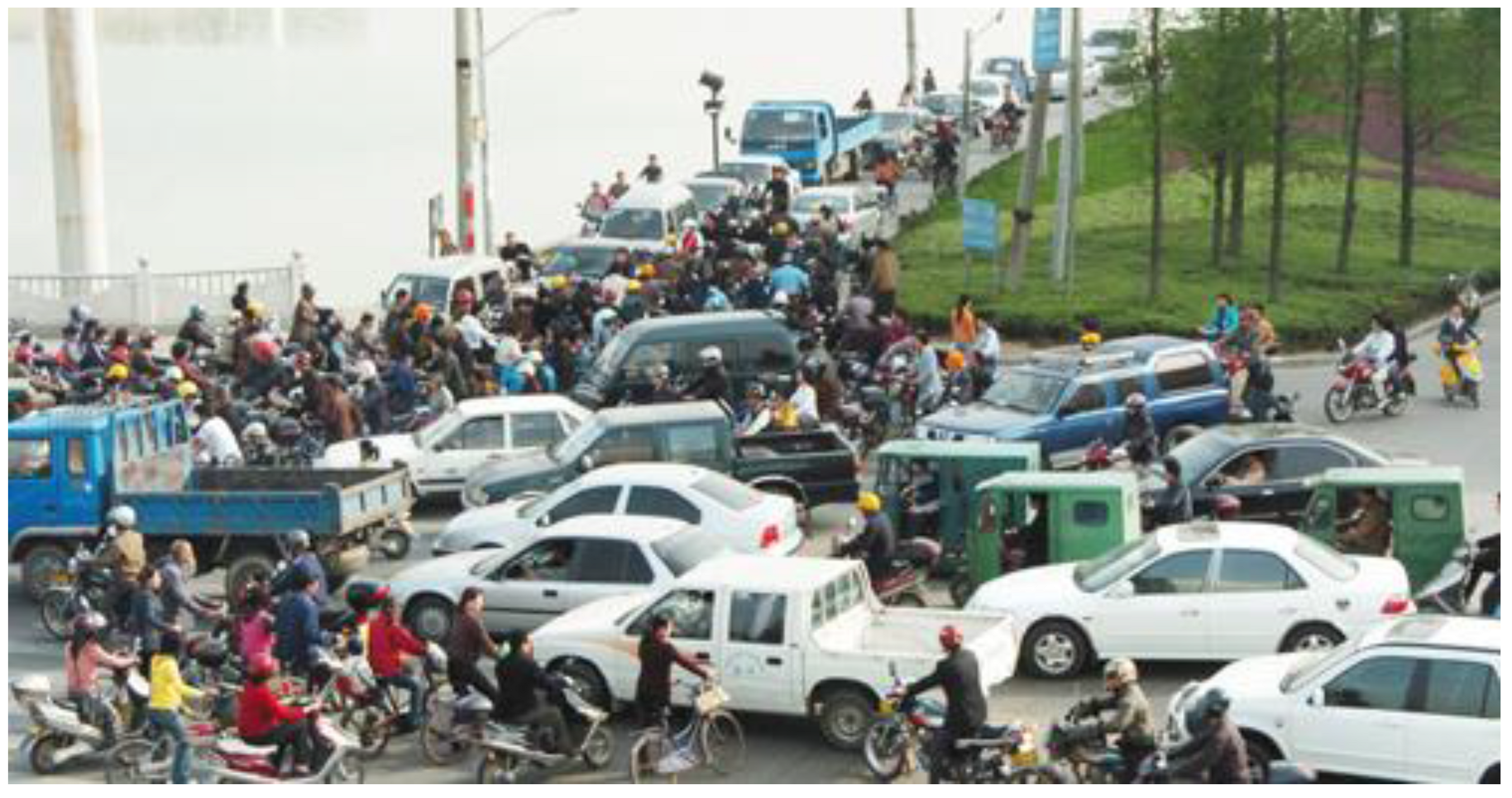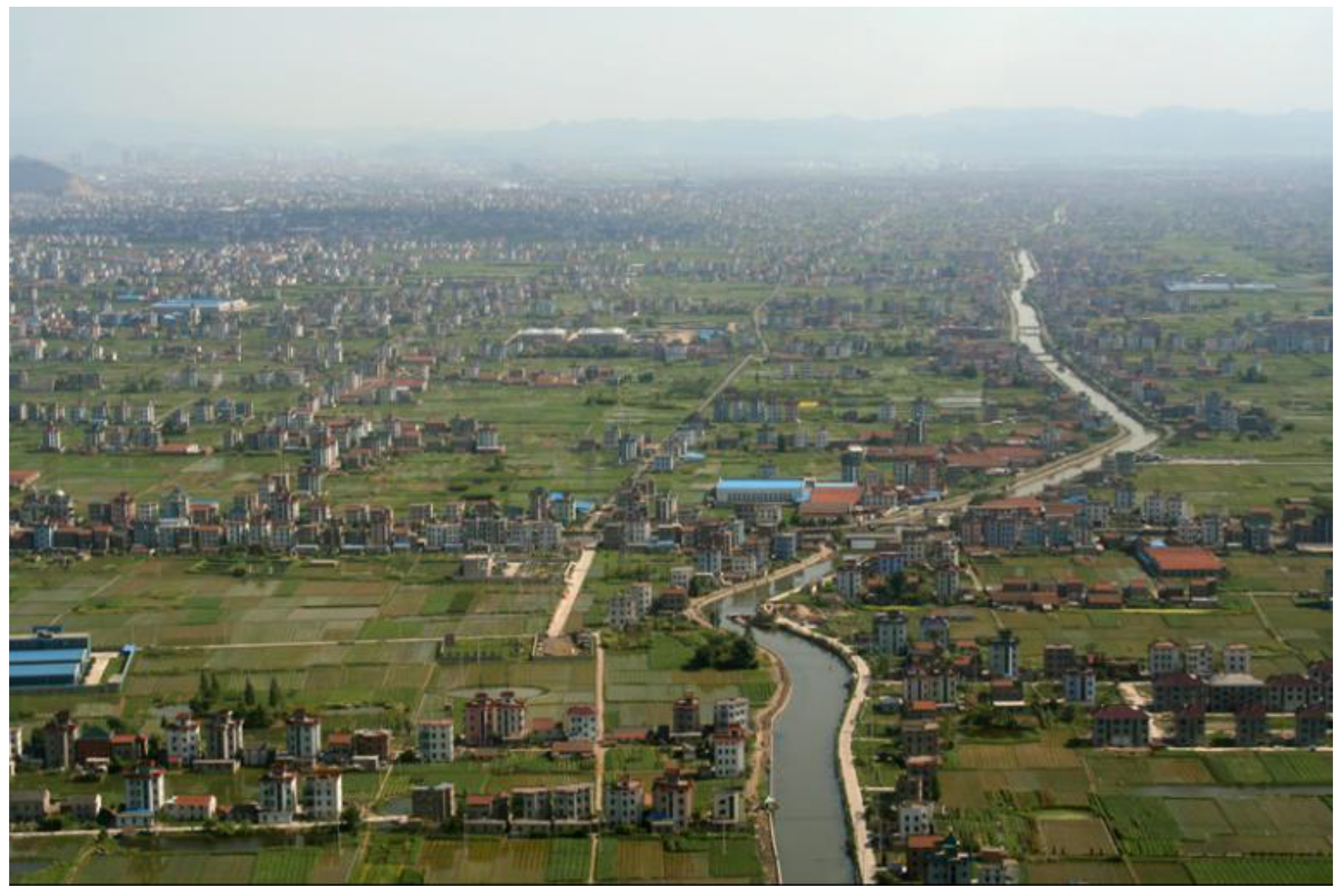Policy and Planning Challenges to Promote Efficient Urban Spatial Development during the Emerging Rapid Transformation in China
Abstract
:1. Introduction
2. Land Use and Development in the Pre-Reform Period

3. Land Development in Post-Reform Era

4. Emerging Urban Spatial Patterns in Post-Reform Era
4.1. Dispersed Employment Concentrations

4.2. Fragmented CBD Development

4.3. Over Scaled Land Development

4.4. Leapfrogging Development

4.5. Whack-a-Mole Development
5. How Do We Understand China’s Urban Spatial Changes and Land Development?
5.1. Decentralization

5.2. Fiscal Incentives

5.3. Developers and Individual Stockholders
5.4. Institutional Arrangement for Land Use and Development
Land ownership, land conversion, and public finance
Farmland protection
Role of land
5.5. Fragmented Planning System
Fragmentation
Issues and problems
Ill-designed planning regulations
6. Final Remarks
References
- Duranton, G.; Puga, D. Micro-foundations of urban agglomeration economies. In Handbook of Regional and Urban Economics; Vernon Henderson, J., Jacques-François, T., Eds.; North-Holland: Amsterdam, the Netherlands, 2004; Vol. 4, pp. 2063–2117. [Google Scholar]
- Boarnet, M.; Crane, R. Travel by Design: the Influence of Urban form on Travel; Oxford University Press: London, UK, 2001. [Google Scholar]
- Marshall, J. Energy-efficient urban form: reducing urban sprawl could play an important role in addressing climate change. Environ. Sci. Technol. 2008, 42, 3133–3137. [Google Scholar] [CrossRef] [PubMed]
- Brueckner, J.K. The Structure of Urban Equilibria: a Unified Treatment of the Muth-Mills Model. In Handbook of Regional and Urban Economics; Mills, E.S., Ed.; North-Holland: Amsterdam, the Netherlands, 1987; Vol. 2, pp. 821–846. [Google Scholar]
- Bertaud, A.; Malpezzi, S. The spatial distribution of population in 48 world cities: implications for economies in transition. Available online: http://alain-bertaud.com/AB_Files/Spatia_%20Distribution_of_Pop_%2050_%20Cities.pdf (accessed 2003).
- Dowall, D.E.; Treffeisen, P.A. Spatial transformation in cities of the developing world: multinucleation and land-capital substitution in Bogota, Colombia. Regional Sci. Urban Econ. 1991, 21, 201–224. [Google Scholar] [CrossRef]
- McDonald, F.J. Capital-land substitution in urban housing: a survey of empirical estimates. J. Urban Econ. 1981, 9, 190–211. [Google Scholar] [CrossRef]
- Maskell, P.; Lorenzen, M. The cluster as market organization. Urban Studies 2004, 41, 991–1009. [Google Scholar] [CrossRef]
- Jaffe, A.; Trajtenberg, M.; Henderson, R. Geographic localization of knowledge spillovers. Quarterly J. Econ. 1993, 63, 577–598. [Google Scholar] [CrossRef]
- Phelps, N.A. Clusters, dispersion and the spaces in between: for an economic geography of the Banal. Urban Studies 2004, 41, 971–989. [Google Scholar] [CrossRef]
- Storper, M.; Venables, A.J. Buzz: face-to-face contact and the urban economy. J. Econ. Geog. 2004, 4, 4. [Google Scholar]
- Feldman, M.; Audretsch, D. Innovation in cities: science-based diversity, specialization, and localized competition. Eur. Econ. Rev. 1999, 43, 409–429. [Google Scholar] [CrossRef]
- Fischel, W.A. Property taxation and the Tiebout model: Evidence for the benefit view from zoning and voting. J. Econ. Literature 1992, 30, 171–177. [Google Scholar]
- Fischel, W.A. Homevoters, municipal corporate governance, and the benefit view of the property Tax. National Tax J. 2001, 54, 157–174. [Google Scholar]
- Nelson, A.C.; Genereux, J.; Genereux, M. Price effects of landfills on house values. Land Econ. 1993, 68, 359–365. [Google Scholar] [CrossRef]
- Pettit, C.L.; Johnson, C. The impacts on property values of solid waste facilities. Waste Age. 1987, 18, 97–106. [Google Scholar]
- Li, M.; Brown, H.J. Micro-neighborhood externalities and hedonic housing prices. Land Econ. 1980, 54, 124–141. [Google Scholar]
- Bertaud, A. Metropolis: a measure of the spatial organization of 7 large cities. 2001; (in press). [Google Scholar]
- Lin, G.C.S. Metropolitan development in a transitional socialist economy: spatial restructuring in the Pearl River Delta, China. Urban Studies 2001, 38, 383–406. [Google Scholar] [CrossRef]
- Lin, G.C.S. Reproducing spaces of Chinese urbanisation: new city-based and land-centred urban transformation. Urban Studies 2007, 44, 1827–1855. [Google Scholar] [CrossRef]
- Wu, F. Urban restructuring in China's emerging market economy: towards a framework for analysis. Int. J. Urban Reg. Res. 1997, 21, 640–663. [Google Scholar] [CrossRef]
- Gaubatz, P.R. Urban transformation in post-Mao China: impacts of the reform era on China’s urban form. In Urban Spaces in Contemporary China: the Potential for Autonomy and Community in Post-Mao China; Davis, D.S., Kraus, R., Naughton, B., Perry, E.J., Eds.; Woodrow Wilson Center Press/Cambridge University Press: Washington, DC, USA, 1995; pp. 28–60. [Google Scholar]
- Bertaud, A. The spatial organization of cities: deliberate outcome or unforeseen consequence? 2004; (in press). [Google Scholar]
- Deng, X.; Huang, J.; Rozelle, S.; Uchida, E. Cultivated land conversion and potential agricultural productivity in China. Land Use Policy 2006, 23, 372–384. [Google Scholar] [CrossRef]
- Seto, K.C.; Kaufman, R.K. Modeling the drivers of urban land use change in the Pearl River Delta, China. Land Econ. 2003, 79, 106–121. [Google Scholar] [CrossRef]
- Liu, S. Functions of the land in city-expanding: report of investigation in three cities (countries) of Zhejiang Province. In Presented at the Joint Workshop by World Bank and Development Research Center of the State Council; Beijing, China, January 2007. [Google Scholar]
- Mobrand, E. Politics of cityward migration: an overview of China in comparative perspective. Habitat Int. 2004, 30, 261–274. [Google Scholar] [CrossRef]
- Ciccone, A.; Hall, R. Productivity and the density of economic activity. Am. Econ. Rev. 1996, 86, 54–70. [Google Scholar]
- Gabe, T.M. Establishment growth in small cities and towns. Int. Regional Sci. Rev. 2004, 2, 164–186. [Google Scholar] [CrossRef]
- Sedgley, N.; Elmslie, B. The geographic concentration of knowledge: scale, agglomeration, and congestion in innovation across U.S. States. Int. Regional Sci. Rev. 2004, 27, 111–137. [Google Scholar] [CrossRef]
- Cervero, R. The Master Planned Transit Metropolis: Singapore. In The Transit Metropolis: A Global Inquiry; Island Press: Washington, DC, USA, 1998; pp. 155–180. [Google Scholar]
- Richardson, H.W.; Bae, C.C.; Jun, M. Migration and the Urban System of South Korea. In International Handbook of Urban Systems: Studies of Urbanization and Migration in Advanced and Developing Countries; Geyer, H.S., Ed.; Edward Elgar: Cheltenham, UK, 2002; pp. 503–524. [Google Scholar]
- Cervero, R.; Wu, K.L. Sub-centering and commuting: evidence from the San Francisco Bay Area, 1980-1990. Urban Studies 1998, 35, 1059–1076. [Google Scholar] [CrossRef]
- McMillen, D.P. Employment Subcenters in Chicago: Past, Present, and Future Economic Perspectives; Federal Reserve Bank of Chicago, 2003. [Google Scholar]
- McDonald, F.J.; Prather, P. Suburban employment centers: the case of Chicago. Urban Studies 1994, 2, 201–218. [Google Scholar] [CrossRef]
- Naess, P.; Sandberg, S.L. Workplace Location, Modal split and energy use for commuting trips. Urban Studies 1996, 33, 557–580. [Google Scholar] [CrossRef]
- Levine, J. Employment suburbanization and the journal to work. Ph.D. Dissertation, Department of City and Regional Planning, UC Berkeley, 1990. [Google Scholar]
- Crane, R.; Chatman, D.G. As jobs sprawl, whither the commute? Access 2003, 23, 14–19. [Google Scholar]
- Murphy, R. The Central Business District; Longman Publisher: Chicago, IL, USA, 1972. [Google Scholar]
- Ding, C. Assessing urban spatial growth patterns in China during rapid urbanization. In The Chinese Economy; (in press).
- Ding, C. Consequences of Land Policy in China: Deciphering Several Emerging Urban Forms. In Smart Growth in China; Song, Y., Ding, C., Eds.; Lincoln Institute of Land Policy: Cambridge, USA, 2009. [Google Scholar]
- Growing Smart Legislative Guidebook: Model Statutes for Planning and Management of Change; Phase I interim edition; American Planning Association: Chicago, IL, USA, 1997.
- Qian, R.; Weingast, B.R. China’s transition to markets: market preserving federalism, Chinese style. J. Policy Reform 1996, 1, 149–185. [Google Scholar] [CrossRef]
- Blanchard, O.; Shleifei, A. Federalism with and without political centralization: China versus Russia. IMF Staff Papers 2001, 48, 171–179. [Google Scholar]
- Montinola, G.; Qian, R.; Weingast, B.R. Federalism, Chinese style: the politics basis for economic success. World Polit. 1996, 48, 50–81. [Google Scholar] [CrossRef]
- Wong, C.; Bhattasali, D. China: National Development and Sub-national Finance; CITIC Publishing House: Beijing, China, 2003. [Google Scholar]
- Xie, F.; Long, G.; Ding, C. China Real Estate Taxation System; China Land Press: Beijing, China, 2005. [Google Scholar]
- Ding, C. Land use policy reform in China: assessment and prospects. Land Use Policy 2003, 20, 109–120. [Google Scholar] [CrossRef]
- Meng, X.; Li, Y. Urban land supply in the Chinese transitional economy: case studies in Beijing and Shenzhen. In Emerging land and housing markets in China; Ding, C., Song, Y., Eds.; Lincoln Institute of Land Policy: Cambridge, USA, 2005; pp. 125–140. [Google Scholar]
- Yeh, A.G.O.; Wu, F.L. The new land development process and urban development in Chinese cities. Int. J. Urban Regional Res. 1996, 20, 330–353. [Google Scholar] [CrossRef]
- Lin, G.C.S.; Ho, S.P.S. The state, land system, and land development processes in contemporary China. Ann. Assn. Amer. Geogr. 2005, 95, 411–436. [Google Scholar]
- Lichtenberg, E.; Ding, C. Assessing farmland protection policy in China. Land Use Policy 2008, 25, 59–68. [Google Scholar] [CrossRef]
- Deng, X.; Huang, J.; Rozelle, S.; Uchida, E. Growth, population and industrialization and urban land expansion in China. J. Urban Econ. 2008, 63, 96–115. [Google Scholar] [CrossRef]
- Ding, C.; Litchenberg, E. Land and urban economic growth in China. In J. Regional Sci.; (in press).
- Leaf, M.; Hou, L. The “third spring” of urban planning in China. China Information 2008, 20, 553–585. [Google Scholar] [CrossRef]
- Yang, W. Theoretical Inquiry in Reform of Planning System (Guihua Tizhi Gaige de Lilun Tantao); China Price Publisher (Zhongguo Wujia Chubanshe): Beijing, China, 2003. [Google Scholar]
© 2009 by the authors; licensee Molecular Diversity Preservation International, Basel, Switzerland. This article is an open-access article distributed under the terms and conditions of the Creative Commons Attribution license (http://creativecommons.org/licenses/by/3.0/).
Share and Cite
Ding, C. Policy and Planning Challenges to Promote Efficient Urban Spatial Development during the Emerging Rapid Transformation in China. Sustainability 2009, 1, 384-408. https://0-doi-org.brum.beds.ac.uk/10.3390/su1030384
Ding C. Policy and Planning Challenges to Promote Efficient Urban Spatial Development during the Emerging Rapid Transformation in China. Sustainability. 2009; 1(3):384-408. https://0-doi-org.brum.beds.ac.uk/10.3390/su1030384
Chicago/Turabian StyleDing, Chengri. 2009. "Policy and Planning Challenges to Promote Efficient Urban Spatial Development during the Emerging Rapid Transformation in China" Sustainability 1, no. 3: 384-408. https://0-doi-org.brum.beds.ac.uk/10.3390/su1030384



